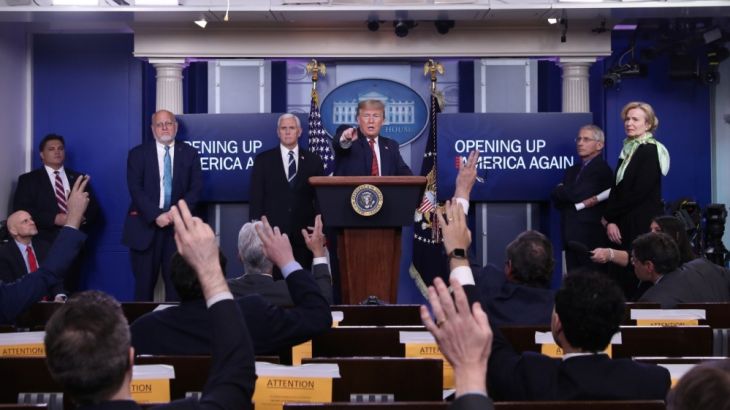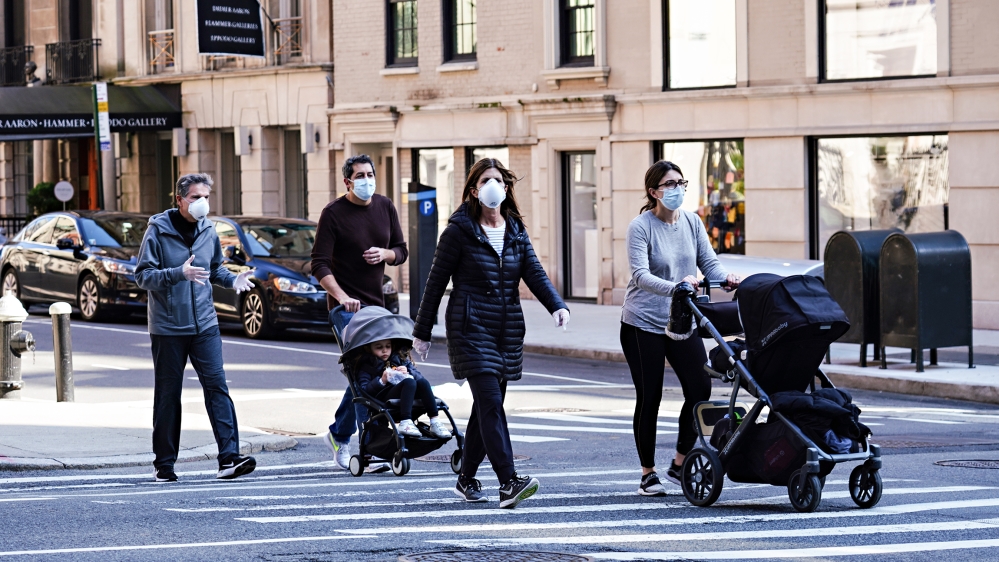Trump’s approach to reopen economy leaves decisions to governors
The new guidelines make clear that the return to normalcy will be a far longer process than Trump initially envisioned.

US President Donald Trump gave governors a road map on Thursday for recovering from the economic pain of the coronavirus pandemic, laying out “a phased and deliberate approach” to restoring normal activity in places that have strong testing and are seeing a decrease in COVID-19 cases.
“We’re starting our life again,” Trump said during his daily press briefing. “We’re starting rejuvenation of our economy again.”
Keep reading
list of 3 itemsWorld reacts to Trump withdrawing WHO funding
Who is to blame: President Trump or the WHO?
He added, “This is a gradual process.”
The new guidelines are aimed at clearing the way for an easing of restrictions in areas with low transmission of the coronavirus, while keeping them in place in harder-hit locations.
Places with declining infections and strong testing would begin a three-phased gradual reopening of businesses and schools, with each phase lasting at least 14 days, meant to ensure that the virus outbreak does not accelerate again.
The recommendations make clear that the return to normalcy will be a far longer process than Trump initially envisioned, with federal officials warning that some social distancing measures may need to remain in place through the end of the year to prevent a new outbreak.

“We are not opening all at once, but one careful step at a time,” Trump said during the White House briefing.
At the earliest, the guidelines suggest that some parts of the country could see a resumption in normal commerce and social gatherings after a month of evaluating whether the easing of restrictions leads to a resurgence in virus cases. In other parts of the country, or if virus cases resume an uptick, it could be substantially longer.
Trump briefed the country’s governors on the plan on Thursday afternoon, saying they were going to be responsible for deciding when it is safe to lift restrictions in their states. That was different from the tone he set earlier this week, when he said he had “total” authority on when and how the country reopened.
“You’re going to call your own shots,” Trump told governors, according to an audio recording obtained by The Associated Press news agency. “We’re going to be standing alongside of you.”
New task force
Meanwhile, under the federal guidelines, those most susceptible to the respiratory disease would be advised to remain sheltered in place until their area enters the final phase – and even then, they are advised to take precautions to avoid close contact with other people.
The federal guidelines come after seven governors in the Midwest announced on Thursday that they would coordinate on reopening the economy, after similar pacts were announced earlier this week in the west and northeast.

Trump held conference calls earlier on Thursday with legislators he named to a new congressional advisory task force. The economic costs were clear in new federal data showing that at least 22 million Americans have been thrown out of work in the last month. But the legislators repeatedly urged the president not to sacrifice public health in an effort to reopen the economy.
“My highest priority on this task force will be to ensure the federal government’s efforts to reopen our economy are bipartisan, data-driven and based on the expertise of public health professionals,” said Democratic Senator Mark Warner of Virginia.
Business leaders, too, raised concerns to the president in a round of calls on Wednesday, warning that a dramatic increase in testing and wider availability of protective equipment would be necessary before they could safely revive operations.
Gradual recovery
The federal government envisions a gradual recovery from the virus, in which disruptive mitigation measures may be needed in some places at least until a vaccine is available – a milestone unlikely to be reached until sometime next year.
“It’s not going to immediately be a situation where we have stadiums full of people,” said US Housing and Urban Development Secretary Ben Carson on Thursday. “We’re Americans. We will adapt,” he added.
New Jersey Governor Phil Murphy said at a news conference before the call with the White House that he planned to ask the president for “direct cash assistance”, citing the state’s troubled tax revenues. He also said he would press for “robust healthcare infrastructure” and mass testing with quick turnaround times before reopening the economy.

Trump said Wednesday that data indicated the US is “past the peak” of the COVID-19 epidemic. He said the numbers have “put us in a very strong position to finalise guidelines for states on reopening the country.”
Dr Deborah Birx, the White House coronavirus task force coordinator, added that data from across the country showed the nation “improving”, but that Americans had to recommit to social distancing to keep up the positive momentum.
She said nine states had fewer than 1,000 cases and just a few dozen new cases per day. She said those would likely be the first to see a lifting in social distancing restrictions at the direction of their governors under the guidelines set to be released on Thursday.
But participants in a Wednesday call with Trump that included executives of dozens of leading American companies raised concerns about the testing issue, according to one participant who spoke on condition of anonymity to describe the private discussion.
Another participant said it was stressed to Trump that expansion of testing and contact tracing was crucial, as well as guidelines for best practices on reopening businesses either in phases or in one fell swoop.
The participant said those on the call noted to the administration that there was about to be a rush on personal protective equipment. Many businesses that are now shuttered will need the protective equipment to keep their employees and customers safe.
Trump was told “the economy will look very different and operations will look very different”, one participant said.
South Carolina Senator Lindsey Graham, a Republican close to Trump, said the lack of widespread testing was an impediment to lifting the social distancing guidelines. “We are struggling with testing at a large scale,” he told ABC’s The View. “You really can’t go back to work until we have more tests.”
But some of Trump’s conservative allies, like economist Stephen Moore, have encouraged him to act swiftly, warning of “a mini Great Depression if we keep the economy shut down”.
“That is a catastrophic outcome for our country. Period,” Moore said he advised the president. “We can’t have 30 million people in this country unemployed, or you’re going to have social chaos.”
The panel, which Trump dubbed the new Great American Economic Revival Industry Groups, also could help give him a measure of cover. If cases surge once restrictions are lifted, as many experts have warned they will, Trump will be able to tell the public he did not act alone and the nation’s top minds – from manufacturing to defence to technology – helped shape the plan.